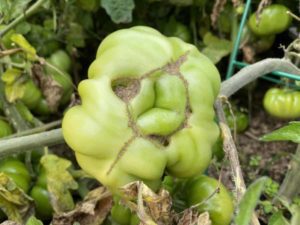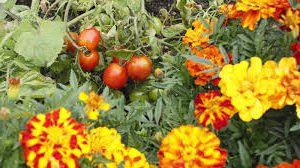When I started out growing tomatoes, there was a day I noticed some tomato flowers falling off. Naturally, I got concerned because in my beginner’s mind one flower makes one fruit, and losing one fruit was a stab at my pocket. The condition is called blossom drop or flower drop as the name suggests and has the potential to reduce your harvest.
Tomato blossom drop or flower abortion is usually a sign of stress due to extreme temperatures, extreme humidity levels, lack of nitrogen which is crucial to plant development, lack of water, failed pollination, and physical activity from humans and insects. Regularly checking on these elements will help you detect the problem sooner and introduce countermeasures.
Temperature levels
Tomato plants are very sensitive to temperature. When the temperature around your farm or greenhouse goes above 29 degrees Celcius during the day or 21 degrees Celcius during the night, your flowers will drop. environment. Healthy tomato plants need temperatures of between 21°C and 29°C to flower and produce good fruits.
At night, the temperature should not go above an average of 21 degrees Celcius or below 13 degrees Celcius. The temperature difference is because plants produce already produce a lot of heat from respiration. Lower night temperatures will reduce the rate of respiration which the plant uses to produce energy.
Pollen grains are affected by the extremely low or high night temperature which makes them enviable. As a result, no pollination will occur resulting in the plant dropping those unpollinated flowers.

The magnitude of the damage increases with prolonged exposure to temperatures outside optimum ranges. In such a case, you will lose both flowers and fruits because the plant will focus its energy on trying to survive. This also happens when the tomato plant is sick.
In a greenhouse, you can put in measures to control the internal temperature but outside you will be at the mercy of the weather. For instance, you can grow tomatoes in the greenhouse during winter by installing heating and lighting systems because the heat will not escape.
Humidity levels
Humidity is the amount of moisture in the air. Tomato plants need between 40% to 70% humidity using a humidity meter.
Outside the ideal ranges, pollination may not occur. Your tomato flowers will produce little to no pollen grains causing tomato flowers falling off. Pollen grains also have a challenge sticking to the stigma (female part of the flower) of the flower.
In times when the humidity drops, you can solve this by spraying some water on the leaves to cool the leaves and raise the humidity.
However, you cannot do this when your plants have a fungal infection or when the humidity is high.
Lack of pollination
You have read above that pollination will not take place under certain humidity and temperature levels.
When pollination does not occur, it may result in tomato flowers falling off. The flower pedicel (flower stalk) begins to turn yellow and dry up. The entire flower also dries and falls off. Do not be surprised to see some dried flowers still clinging onto the tree because that happens occasionally.
Pollination is a collaborative process and depends on the help of insects, birds, animals and wind to occur. This is why the rate of pollination in greenhouses is low where there is no direct action put in place to assist pollination.
Insects will land on your flowers and shake them up releasing pollen grains. The pollen grain may fall on the female part of the same flower on be carried off to another flower on the insect’s body. The wind also transfers pollen grains.
In the greenhouse, you can gently shake the trellises and the vibration will release pollen grains and fertilize the flower.

When pollination fails, you will experience blossom drop with your tomato plants.
Nitrogen levels in the plant
Nitrogen is a key nutrient in tomato plant growth. It helps during the vegetative phase when the plant needs to grow the leaves, stems and branches.
High levels of nitrogen in the soil or from foliar sprays, leads to aggressive primary growth. It also inhibits the production and growth of flowers sometimes leading to tomato flowers falling off because the plant is focusing on vegetative growth.
Low levels of nitrogen in the plant will result in your plants having thin stems that will not support fruit setting.
Diseases
Some diseases such as fungal diseases may attack the flower cluster areas. Diseases like blight attack the stem and spread to the fruiting structures. Once there, you will see your flower stalk turn black and dry up and tomato flowers falling off. This will kill the flower attached to the stalk.
Tomato diseases also push your plant to go into survival mode. When in survival mode, your plants will focus all their energy on defenses and repairing themselves leaving fruit production to suffer.
Animal, birds, insects and human activity
As you are moving through your farm doing daily routine tasks, you should be careful not to shake the flowers aggressively or wear clothes flowers might attach to and get pulled off the plant.
Animals and birds may also cause blossom drop. As they feed, they might brush up against the flowers, the movement can be so rough that the flowers drop to the ground.
Bees also vibrate while they are on nectar. This process of vibration is called sonication. When the vibrations are too strong some flowers tend to fall off the tomato plant.
How to prevent tomato blossom drop/flower abortion
Planting tolerant tomato varieties
As you can see, many blossom drop cases come from stress of some kind. It could be any of the causes I’ve touched on above. If you are planning on farming in a hot area then a heat-tolerant variety is great in addition to disease tolerance.
Tolerant varieties are hybrid crops and perform very well. However, they are more expensive because of the added benefits. With great nurture, hybrid seeds are definitely worth the purchase.
Monitor nitrogen levels
Nitrogen levels should be monitored using a soil test. You can add more fertilizer if the nitrogen level in the soil is low, add more fertilizer. However, if the level is high, you can flood the farm or container to drain the excess nutrients.
Reduce human and animal and insect activity around the farm
You cannot do away with human movement on the farm but you make them fewer, intentional and careful to ensure your crops are not hurt in the process. In addition, you should fence the farm off, in the beginning, other animals from gaining access. In a greenhouse, you should keep your doors closed at all times.
Complement pollination activities
In the farm, pollination can occur naturally or you can induce it by introducing a bee colony near the farm or a bumblebee colony in the greenhouse for pollination. You can also shake the trellises if you are in the greenhouse just to be sure.
Irrigate deeply
Tomato plants have very active root systems that can go up to 5ft deep. With such deep roots, they need the soil to be moist all the way down to 5ft. Therefore, irrigate regularly and with enough water to soak the soil around the plant so that it drains to deeper soil.
You can do this every 4 days and mark it in your irrigation calendar.
Summary
Because the causes of tomato flower blossom drop are closely linked to stress, then prevent stress in the plant is a key step in making sure your plant thrive. Issues like lack of water, extremes in nitrogen supply, poor pollination, temperature and humidity can easily be tested and treated. You should check on these parameters every day if you can so that you detect slight changes early enough that measures, like irrigating deeply and spraying water on the leaves, you introduce will work.





[…] You will not worry much about fruit setting when dealing with determinate tomatoes. This type of tomato sets fruits quickly and they come all at once. Unless they suffer from stress or blossom drop. […]
[…] You will not worry much about fruit setting when dealing with determinate tomatoes. This type of tomato sets fruits quickly and comes all at once unless they suffer from stress or blossom drop. […]
[…] growth where tomatoes don’t grow tall. As the plant starts to flower, water stress leads to flowers dropping or getting aborted (blossom drop). When the tomato plant matures, water stress leads to immature or small but mature […]
[…] 6 Reasons why your tomato flowers are falling from the plant? (Blossom drop) […]